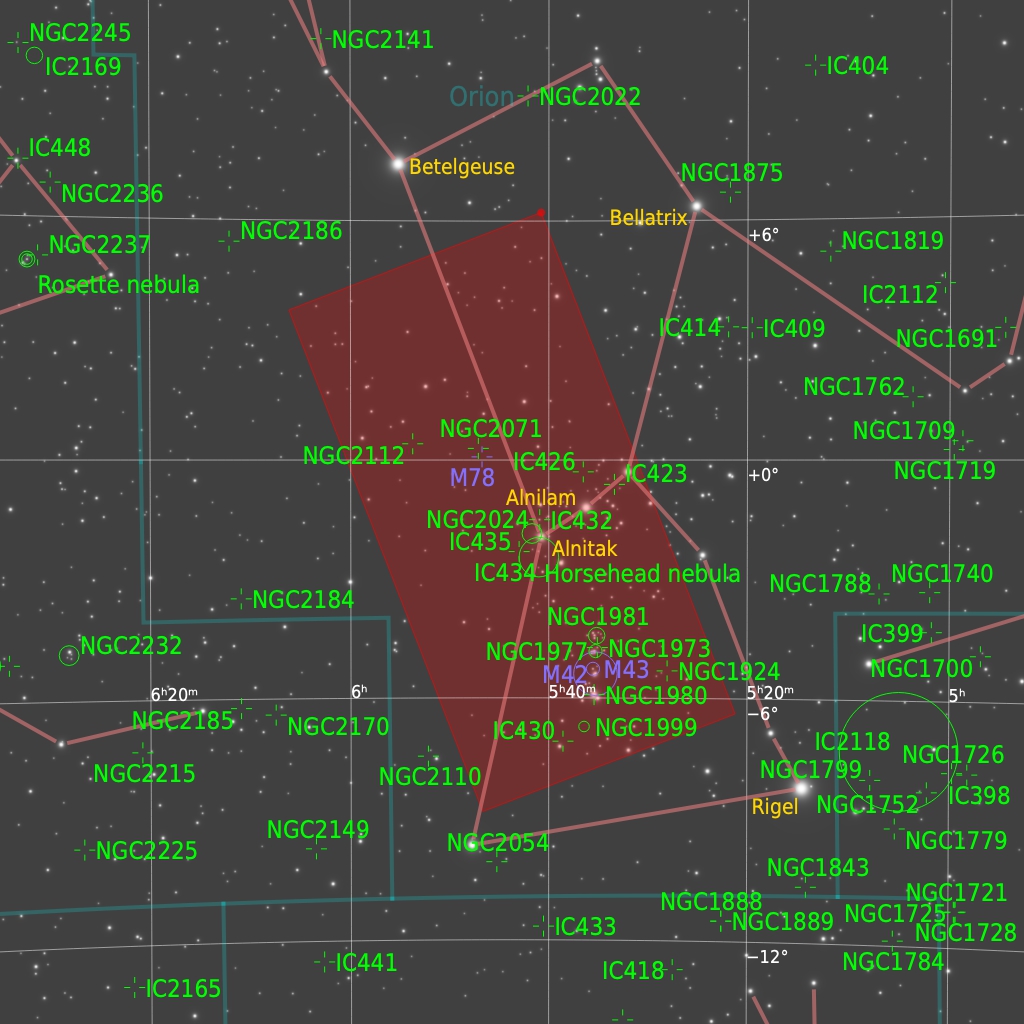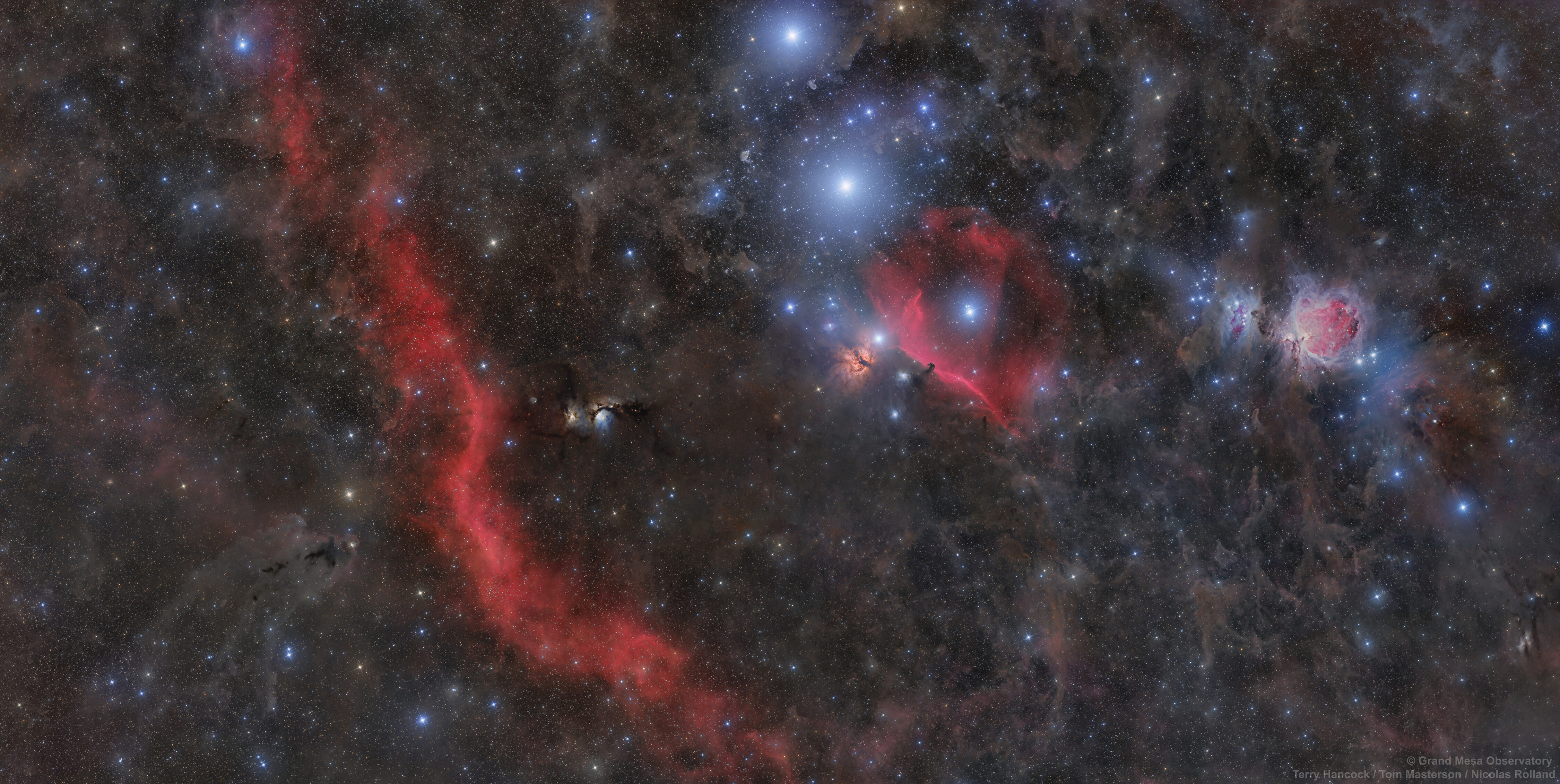The Amazing Clouds of Orion
IC 434, LDN 1622, Messier 42, Messier 78, Sh 2-276
What started off as a 3 panel mosaic covering The Great Nebula in Orion, The Horsehead, Barnards Loop and M78 soon became a much larger project including over 20 deep space objects and the majority of the Orion Molecular Cloud. The final mosaic image (12 panels) covers 13.5 x 6.8 degrees of our night’s sky.
The detail captured in this image is best seen by looking at the 1.99 arcsecond per pixel full resolution 1.8 gigabyte mosaic which can be viewed as a full-page website here.
Dominating the night sky from December through March, the ancient constellation Orion is one of the most famous and most photographed star groups in the heavens. The ancient Greeks associated these stars with a mighty hunter adorned with a belt and sword, holding a westward-facing shield in his left hand and an upraised club in his right. These stars were even included in the fictional world of J.R.R. Tolkien where they were called Menelvagor, the “Swordsman of the Sky”.
This image is a collaborative project between: Terry Hancock, Tom Masterson & Nicolas Rolland.
Ce qui a commencé comme une mosaïque de trois panneaux couvrant la Grande Nébuleuse d’Orion, la Tête de cheval, la Boucle de Barnard et Messier 78 est rapidement devenu un projet beaucoup plus vaste comprenant plus de 20 objets du ciel profond ainsi que la majorité du Nuage Moléculaire d’Orion. L’image finale, une mosaïque de 12 panneaux, couvre 13,5 x 6,8 degrés du ciel.
L’ensemble des détails de cette mosaïque, d’une résolution de 1,99 seconde d’arc/pixel et de 1,8 gigaoctet, peut être consulté ici.
Dominant le ciel nocturne de décembre à mars, la constellation d’Orion est l’un des groupes d’étoiles les plus célèbres et les plus photographiés du ciel. Les Grecs de l’Antiquité associaient ces étoiles à un puissant chasseur vêtu d’une ceinture et d’une épée, tenant un bouclier orienté vers l’ouest dans sa main gauche et une massue levée dans sa poignée droite. Ces astres ont même été inclus dans le monde fictif de J.R.R. Tolkien, où elles étaient appelées Menelvagor, « l’épéiste céleste ».
Cette image est le résultat d’un travail collaboratif entre Terry Hancock, Tom Masterson et Nicolas Rolland.
TECHNICAL DATA
ACQUISITION DETAILS
OPTICS Takahashi E-180 Astrograph
CAMERA QHY367 Pro C Full Frame One Shot Color CMOS
MOUNT Paramount GT1100S (MKS 4000)
FILTERS N/A
LOCATION The Grand Mesa Observatory, Whitewater, CO
DATE January 2022
EXPOSURES (TOTAL) 33.1 hours
EXPOSURES (ORION CLOUDS) 27.1 hours (OSC 813 x 120 sec, R 45 x 120 sec, G 40 x 120 sec, B 38 x 120 sec, Ha 24 x 600 sec)
EXPOSURES (M42) 3.25 hours (L 45 x 120 sec & 28 x 1 sec, R 50 x 120 sec & 28 x 1 sec, G 47 x 120 sec & 26 x 1 sec, B 51 x 120 sec & 21 x 1 sec)
EXPOSURES (IC 434) 2.76 hours (L 43 x 120 sec, R 45 x 120 sec, G 40 x 120 sec, B 38 x 120 sec)
SOFTWARE Pixinsight, PTGui, CCDstack, Photoshop, Registar
CAPTURED & PROCESSED Terry Hancock, Tom Masterson & Nicolas Rolland

TARGET DETAILS
RA 05h 44m 43.1s
DEC -01° 18' 27.1"
SIZE 13.6 x 6.8 deg
ORIENTATION Up is 69 degrees E of N
CONSTELLATION Orion
DISTANCE 1,400 ly
